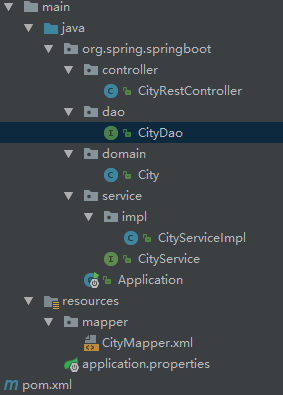发表于: 2017-07-17 22:40:04
1 1087
今天完成的事情:
上午学习了一下springcache,下午写代码,听大师兄讲课,晚上去华科跑了个步
缓存简介
缓存,我的理解是:让数据更接近于使用者;工作机制是:先从缓存中读取数据,如果没有再从慢速设备上读取实际数据(数据也会存入缓存);缓存什么:那些经常读取且不经常修改的数据/那些昂贵(CPU/IO)的且对于相同的请求有相同的计算结果的数据。如CPU--L1/L2--内存--磁盘就是一个典型的例子,CPU需要数据时先从L1/L2中读取,如果没有到内存中找,如果还没有会到磁盘上找。还有如用过Maven的朋友都应该知道,我们找依赖的时候,先从本机仓库找,再从本地服务器仓库找,最后到远程仓库服务器找;还有如京东的物流为什么那么快?他们在各个地都有分仓库,如果该仓库有货物那么送货的速度是非常快的。
缓存命中率
即从缓存中读取数据的次数 与 总读取次数的比率,命中率越高越好:
命中率 = 从缓存中读取次数 / (总读取次数[从缓存中读取次数 + 从慢速设备上读取的次数])
Miss率 = 没有从缓存中读取的次数 / (总读取次数[从缓存中读取次数 + 从慢速设备上读取的次数])
这是一个非常重要的监控指标,如果做缓存一定要健康这个指标来看缓存是否工作良好;
缓存策略
Eviction policy
移除策略,即如果缓存满了,从缓存中移除数据的策略;常见的有LFU、LRU、FIFO:
FIFO(First In First Out):先进先出算法,即先放入缓存的先被移除;
LRU(Least Recently Used):最久未使用算法,使用时间距离现在最久的那个被移除;
LFU(Least Frequently Used):最近最少使用算法,一定时间段内使用次数(频率)最少的那个被移除;
TTL(Time To Live ):存活期,即从缓存中创建时间点开始直到它到期的一个时间段(不管在这个时间段内有没有访问都将过期)
TTI(Time To Idle):空闲期,即一个数据多久没被访问将从缓存中移除的时间。
文件结构

City
import java.io.Serializable;
public class City implements Serializable {
private static final long serialVersionUID = -1L;
/**
* 城市编号
*/
private Long id;
/**
* 省份编号
*/
private Long provinceId;
/**
* 城市名称
*/
private String cityName;
/**
* 描述
*/
private String description;
public Long getId() {
return id;
}
public void setId(Long id) {
this.id = id;
}
public Long getProvinceId() {
return provinceId;
}
public void setProvinceId(Long provinceId) {
this.provinceId = provinceId;
}
public String getCityName() {
return cityName;
}
public void setCityName(String cityName) {
this.cityName = cityName;
}
public String getDescription() {
return description;
}
public void setDescription(String description) {
this.description = description;
}
@Override
public String toString() {
return "City{" +
"id=" + id +
", provinceId=" + provinceId +
", cityName='" + cityName + '\'' +
", description='" + description + '\'' +
'}';
}
}
CityRestController
import org.spring.springboot.domain.City;
import org.spring.springboot.service.CityService;
import org.springframework.beans.factory.annotation.Autowired;
import org.springframework.http.MediaType;
import org.springframework.web.bind.annotation.*;
import java.util.List;
@RestController
public class CityRestController {
@Autowired
private CityService cityService;
@RequestMapping(value = "/api/city/{id}", method = RequestMethod.GET)
public City findOneCity(@PathVariable("id") Long id) {
return cityService.findCityById(id);
}
@RequestMapping(value = "/api/city", method = RequestMethod.POST)
public void createCity(@RequestBody City city) {
cityService.saveCity(city);
}
@RequestMapping(value = "/api/city", method = RequestMethod.PUT)
public void modifyCity(@RequestBody City city) {
cityService.updateCity(city);
}
@RequestMapping(value = "/api/city/{id}", method = RequestMethod.DELETE)
public void modifyCity(@PathVariable("id") Long id) {
cityService.deleteCity(id);
}
}
CityServiceImpl
import org.slf4j.Logger;
import org.slf4j.LoggerFactory;
import org.spring.springboot.dao.CityDao;
import org.spring.springboot.domain.City;
import org.spring.springboot.service.CityService;
import org.springframework.beans.factory.annotation.Autowired;
import org.springframework.data.redis.core.RedisTemplate;
import org.springframework.data.redis.core.StringRedisTemplate;
import org.springframework.data.redis.core.ValueOperations;
import org.springframework.stereotype.Service;
import java.util.List;
import java.util.concurrent.TimeUnit;
@Service
public class CityServiceImpl implements CityService {
private static final Logger LOGGER = LoggerFactory.getLogger(CityServiceImpl.class);
@Autowired
private CityDao cityDao;
@Autowired
private RedisTemplate redisTemplate;
/**
* 获取城市逻辑:
* 如果缓存存在,从缓存中获取城市信息
* 如果缓存不存在,从 DB 中获取城市信息,然后插入缓存
*/
public City findCityById(Long id) {
// 从缓存中获取城市信息
String key = "city_" + id;
ValueOperations<String, City> operations = redisTemplate.opsForValue();
// 缓存存在
boolean hasKey = redisTemplate.hasKey(key);
if (hasKey) {
City city = operations.get(key);
LOGGER.info("CityServiceImpl.findCityById() : 从缓存中获取了城市 >> " + city.toString());
return city;
}
// 从 DB 中获取城市信息
City city = cityDao.findById(id);
// 插入缓存
operations.set(key, city, 10, TimeUnit.SECONDS);
LOGGER.info("CityServiceImpl.findCityById() : 城市插入缓存 >> " + city.toString());
return city;
}
@Override
public Long saveCity(City city) {
return cityDao.saveCity(city);
}
/**
* 更新城市逻辑:
* 如果缓存存在,删除
* 如果缓存不存在,不操作
*/
@Override
public Long updateCity(City city) {
Long ret = cityDao.updateCity(city);
// 缓存存在,删除缓存
String key = "city_" + city.getId();
boolean hasKey = redisTemplate.hasKey(key);
if (hasKey) {
redisTemplate.delete(key);
LOGGER.info("CityServiceImpl.updateCity() : 从缓存中删除城市 >> " + city.toString());
}
return ret;
}
@Override
public Long deleteCity(Long id) {
Long ret = cityDao.deleteCity(id);
// 缓存存在,删除缓存
String key = "city_" + id;
boolean hasKey = redisTemplate.hasKey(key);
if (hasKey) {
redisTemplate.delete(key);
LOGGER.info("CityServiceImpl.deleteCity() : 从缓存中删除城市 ID >> " + id);
}
return ret;
}
}
DAO层就不贴了
明天计划的事情:继续任务6
遇到的问题:用redis跑简单例子没遇到像家铭那样奇怪的情况
收获:听师兄讲课,那个IDEA的依赖树比较好用





评论